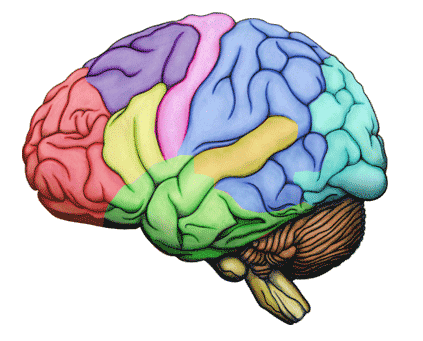
COGNITIVE NEUROSCIENCE

BRAIN GAMES
Your Brain is You: Learning and Memory
Neurophysiology of Learning

BRAIN VIDEOS
The brain’s reticular activating system filters incoming information to focus on what’s important, excluding anything trivial, which leads to meaningful perception (Wolfe, 2001 as cited by Schunk, 2012, p.43). How does the brain know what’s important? Perceived importance is based on factors such as novelty, intensity, and movement. In terms of its application in the classroom, these aspects can be used to maintain student’s attention, and educators can find ways to build these factors into their lessons and student activities.
Sensory inputs are processed in the sensory memories area of the brain and the ones that are retained move to the working memory (WM), which primarily resides in the prefrontal cortex of the frontal lobe. The cortex and medial temporal lobe are involved in memory and information processing. The long-term memory (LTM) is located in the frontal and temporal cortex. The parts of the brain responsible for long-term memory differ based on the type of information, whether it is declarative memory (facts, definitions, events) or procedural memory (procedures, strategies).
Cognitive neuroscience supports the idea that learning occurs through observation (Bandra, 1986, as cited by Schunk, 2012, p. 46). Nonmotor procedures (i.e. decoding words) involve the use of the visual cortex, but repetition can change the neural structure of the visual cortex. These changes allow us to quickly recognize visual stimuli (i.e. words, numbers) without consciously having to process their meaning. Conversely, conscious processing is involved when it requires extended activity (i.e. pausing to understand a passage).
Information Processing System
From a cognitive neuroscience perspective, learning involves “forming and strengthening neural connections and networks (synaptic connections)” (Schunk, 2012, p. 46).
Neural Connections in Memory Networks
Hebb's Theory
Hebb (1949) formulated a neurophysiological theory of learning that highlights the role of two cortical structures: cell assemblies and phase sequences. Cell assemblies are structures with cells in the cortex and subcortical centers. It is the neural counterpart of a simple association that is developed through repeated stimulations. Phase sequence is a series of cell assemblies, which form an organized pattern. Hebb believed that when a cell assembly was activated that it would in turn activate the neural and motor responses. For example, if we repeatedly see a friend’s face, then multiple cell assemblies are activated enabling us to meaningfully perceive who it is.
Thus, Hebb’s theory can be summarized best by this statement “cells that fire together, wire together” as it describes associative learning. Hebb’s theory is still relevant today as it is linked with recent research on how learning occurs and memories are formed.
Neural Connections
Generally, people are born with a large quantity of neural connections. Experiences work on this system so that connections are selected or ignored, strengthened or lost. According to the National Research Council (cited in Schunk, 2012, p. 47), the process of forming and strengthening synaptic connections, essentially learning, changes the physical structure of the brain and alters its organization. Although we tend to think that the brain determines learning, it is a reciprocal relationship since the “neuroplasticity” of the brain or its capacity to change its structure and function is a result of an individual’s experience.
Recent research reveals that memory is not formed at the time learning first occurs. Memory forms as a continuous process called consolidation, where stabilizing and strengthening of neural connections occur in the hippocampus. When teachers use organization, rehearsal, and elaboration, these strategies help the brain impose structure on learning and help with the consolidation of neural connections in memory.
The brain’s cerebral cortex is responsible for reading and the posterior cortical association areas of the left hemisphere are important for understanding language and normal reading. Language and reading require the coordination of various brain areas.
Right Brain vs. Left Brain
The practice of teaching to the right or the left side of the brain is not supported by neuroscience research. Read the following article and watch the short video to discover why.
Article - Left Brain versus Right Brain
Researchers Debunk Myth of "Right-brain" and "Left-brain" Personality Traits - Watch the Video Below!
It has been known for many years that generally the left hemisphere of the brain governs the right visual field and right side of the body, and the right hemisphere regulates the left visual field and left side of the body. Brain research has also identified that analytical thinking seems to be centered in the left side of the brain, and spatial, auditory, emotional, contextual and artistic processing occurs in the right side. However the two hemispheres are joined by bundles of nerve fibers, which allow the free exchange of information between the two sides. Speech is a good example. If you are chatting with a friend, it is the left side of the brain that makes speech possible, but it is the right side of the brain that provides the context and helps you understand meaning.
Different parts of the brain have different functions, but functions are rarely completely localized in one section of the brain. It is important for educators to know that “the practice of teaching to different sides of the brain (right brain, left brain) is not supported by empirical research” (Schunk 2012, p. 39).



